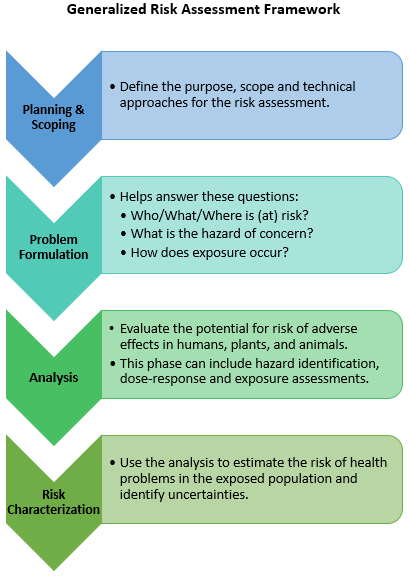Risk Assessment of Pollutants in Biosolids
What is Risk, Generally?
EPA uses risk assessments to characterize the nature and magnitude of health risks to humans (e.g., residents, workers, recreational visitors) and ecological receptors from chemical contaminants and other stressors, that may be present. While there are many definitions of the word risk, EPA considers risk to be the chance of harmful effects to human health or to ecological systems resulting from exposure to an environmental stressor. A stressor is any physical, chemical, or biological entity that can induce an adverse response.
Learn more about risk and EPA’s risk assessment process.
Assessing Pollutants Found in Biosolids through Risk Assessment
40 CFR Part 503 was developed based on the results of risk assessments to identify what, if any, risks were associated with the use or disposal of biosolids via land application, surface disposal, or incineration.
EPA is currently focused on developing tools to efficiently screen pollutants found in biosolids. There are significant gaps in available data to support risk assessment, therefore EPA is also examining the potential use of computational toxicology methods to support the data generation and screening of pollutants identified in biosolids.
- A Guide to the Biosolids Risk Assessments for the EPA Part 503 Rule
This guide was prepared to provide an understanding of the risk assessment process that was conducted as a basis for the Part 503 biosolids rule. The document 1) describes the risk assessment procedures used to develop Part 503 pollutant limits; 2) provides historical accounting and discussion of the steps taken during risk assessment; 3) discusses the issues that arose during the risk assessment process and their resolutions; 4) explains assumptions and policy decisions; and 5) answers commonly asked questions.
Status of Risk Assessment Work on Per- and Polyfluoroalkyl Substances (PFAS) Found in Biosolids
EPA has initiated problem formulation for PFOA and PFOS biosolids risk assessments. The first step in conducting a risk assessment is problem formulation which 1) articulates the purpose for the assessment; 2) defines the problem (source and occurrence); 3) identifies the conceptual exposure pathways; and 4) presents data and tools used for analyzing and characterizing risk. The problem formulation process also involves engagement with states and tribes, risk managers, scientists, and members of the biosolids community regarding foreseeable science and implementation issues.

